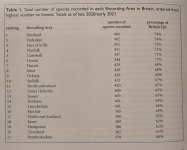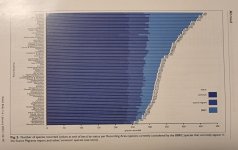Paul Chapman
Well-known member
I have had three patches.
The first was my local walk from my parental home in an urban environment in Harlow (Metropolitan Essex) with low biodiversity but back then wasteground could yield breeding Grey Partridges and Skylarks and wintering Snipes as well as the occasional Lesser Spotted Woodpecker.
My next patch was Amwell Gravel Pits in the Lea Valley on the Essex/Hertfordshire border being 15 mins from my home in Essex. I never watched Amwell religiously because my birding had become more mobile but this was a significant step up with personal highlights being Temminck's Stint, Wryneck and Purple Heron. i found nothing of note.
My current patch is coastal on the Bristol Channel at Clevedon and Portishead still in a relatively impoverished part of the country. I saw a Black-winged Pratincole here before it was my patch & finds have included Kentish Plover, Wryneck, Sabine's Gull and Glossy Ibis. I have seen Franklin's Gull, Spotted Sandpiper, Upland Sandpiper, Caspian Tern, Rose-coloured Starling and Dusky Warbler amongst a patch list in excess of 230. Whilst working, I watched it religiously save when dragged away by lifers and short trips abroad. I now watch it as much now I am retired but also do more birding away from the patch.
I am happy to stay here and bird it for as long as I can despite deteriorating habitat and access and failures by the local conservation bodies and local authorities but I would rather headbut a brick wall repeatedly than move back to an area of lower biodiversity. I could achieve an annual yearlist on foot from home around 140 with a fair wind and determination and a maximum of 150. Inland in Avon, around a 100 away from the reservoirs seems a good patch score.
An idea of relative diversity can be seen in the attached images from a recent BB article.
There is one world birder and twitcher I know that produces find after find in Hertfordshire and another notable similar birder produced find after find around Slough. Astonishingly perseverance and dedication far beyond my levels of skill or motivation.
Just a personal perspective.
All the best
Paul
The first was my local walk from my parental home in an urban environment in Harlow (Metropolitan Essex) with low biodiversity but back then wasteground could yield breeding Grey Partridges and Skylarks and wintering Snipes as well as the occasional Lesser Spotted Woodpecker.
My next patch was Amwell Gravel Pits in the Lea Valley on the Essex/Hertfordshire border being 15 mins from my home in Essex. I never watched Amwell religiously because my birding had become more mobile but this was a significant step up with personal highlights being Temminck's Stint, Wryneck and Purple Heron. i found nothing of note.
My current patch is coastal on the Bristol Channel at Clevedon and Portishead still in a relatively impoverished part of the country. I saw a Black-winged Pratincole here before it was my patch & finds have included Kentish Plover, Wryneck, Sabine's Gull and Glossy Ibis. I have seen Franklin's Gull, Spotted Sandpiper, Upland Sandpiper, Caspian Tern, Rose-coloured Starling and Dusky Warbler amongst a patch list in excess of 230. Whilst working, I watched it religiously save when dragged away by lifers and short trips abroad. I now watch it as much now I am retired but also do more birding away from the patch.
I am happy to stay here and bird it for as long as I can despite deteriorating habitat and access and failures by the local conservation bodies and local authorities but I would rather headbut a brick wall repeatedly than move back to an area of lower biodiversity. I could achieve an annual yearlist on foot from home around 140 with a fair wind and determination and a maximum of 150. Inland in Avon, around a 100 away from the reservoirs seems a good patch score.
An idea of relative diversity can be seen in the attached images from a recent BB article.
There is one world birder and twitcher I know that produces find after find in Hertfordshire and another notable similar birder produced find after find around Slough. Astonishingly perseverance and dedication far beyond my levels of skill or motivation.
Just a personal perspective.
All the best
Paul
Attachments
Last edited:










